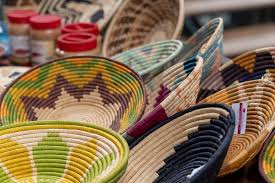
BASKET WEAVING IN UGANDA
The beauty of basket weaving in Uganda lies not only in the craftsmanship and intricate designs but also in the cultural significance and stories woven into each piece. Here are some aspects that make Ugandan basket weaving exceptionally beautiful:
1. Intricate Patterns and Designs: Ugandan baskets are renowned for their intricate patterns, vibrant colors, and geometric designs. Artisans skillfully weave together natural materials such as raffia palm, banana fibers, and papyrus reeds to create visually stunning patterns that reflect the creativity and cultural heritage of the weavers.
2. Rich Cultural Heritage: Each basket tells a story, reflecting the cultural heritage and traditions of the community where it was crafted. From symbols representing fertility and prosperity to motifs inspired by nature and local folklore, Ugandan baskets are imbued with layers of meaning and symbolism that resonate with both the weavers and those who admire their work.
3. Diverse Styles and Techniques: Uganda is home to a diverse array of ethnic groups, each with its own unique style of basket weaving. Whether it’s the coil weaving of the Baganda people, the twining of the Basoga, or the plaiting of the Bakiga, each weaving technique adds to the richness and diversity of Uganda’s basketry tradition.
4. Functional Elegance: While Ugandan baskets are admired for their aesthetic beauty, they are also highly functional. Whether used for storing food, carrying water, or as decorative pieces in homes and ceremonies, these baskets seamlessly blend form and function, adding a touch of elegance to everyday life.
5. Sustainability and Eco-Friendliness: The use of natural, locally sourced materials in basket weaving not only adds to the beauty of the craft but also promotes sustainability and eco-friendliness. By harvesting materials such as raffia palm and banana fibers from the surrounding environment, Ugandan artisans ensure that their craft has minimal environmental impact.
6. Community and Empowerment: Basket weaving is often a communal activity, bringing together women and families in rural communities. Through their craft, Ugandan artisans not only preserve their cultural heritage but also empower themselves economically, providing a source of income and livelihood for themselves and their families.
7. Global Recognition: Ugandan baskets have gained recognition on the global stage, with collectors, designers, and art enthusiasts appreciating their beauty and craftsmanship. By showcasing Ugandan basket weaving internationally, artisans not only find new markets for their work but also promote cross-cultural exchange and appreciation.
In summary, the beauty of basket weaving in Uganda lies in its intricate designs, rich cultural heritage, diverse weaving techniques, functional elegance, sustainability, community involvement, and global recognition. Each basket is a testament to the skill, creativity, and resilience of Uganda’s artisanal tradition and indeed Ugandan Baskets sure do make great souvenirs!
Recent Posts
Boda boda (Motorcycle) use in Uganda.
Uganda Crested Crane
Ziwa Rhino Sanctuary
All Categories
Tags

Thailand




